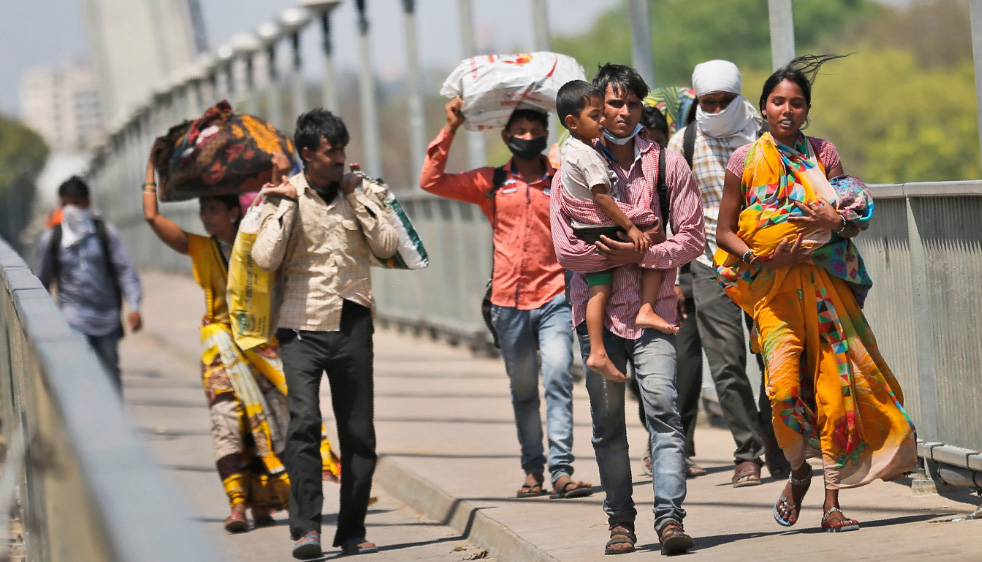
New Delhi, Jan 25: India's 100 top billionaires have seen their fortunes increase by Rs 12,97,822 crore since March last year when the Covid-19 pandemic hit the country and this amount is enough to give 13.8 crore poorest Indians a cheque for Rs 94,045 each.
The latest India supplement of the Oxfam report 'The Inequality Virus' said it would take an unskilled worker 10,000 years to make what businessman Mukesh Ambani made in an hour during the pandemic and three years to make what he made in a second.
The report has been released on the opening day of the World Economic Forum's 'Davos Dialogues'.
Calling the coronavirus pandemic the world's worst public health crisis in a hundred years, the report said it triggered an economic crisis comparable in scale only with the Great Depression of the 1930s.
"India's 100 billionaires have seen their fortunes increase by Rs 12,97,822 crores since March last year which is enough to give every one of the 138 million poorest Indians a cheque for Rs 94,045 each," the report said.
The new global survey of 295 economists from 79 countries, commissioned by Oxfam, reveals that 87 per cent of respondents, including Jeffrey Sachs, Jayati Ghosh and Gabriel Zucman, expect an "increase" or a "major increase" in income inequality in their country as a result of the pandemic.
"India has the world's fourth lowest health budget in terms of its share of government expenditure," it said. "If India's top 11 billionaires are taxed at just 1 per cent on the increase in their wealth during the pandemic, it will be enough to increase the allocation of Jan Aushadi Scheme by 140 times, which provides affordable medicines to the poor and marginalized."
India introduced one of the earliest and most stringent lockdowns in the face of the pandemic and its enforcement brought the economy to a standstill, triggering unemployment, hunger, distress migration and untold hardship in its wake, the report said.
"The rich were able to escape the pandemic's worst impact; and while the white-collar workers isolated themselves and worked from home, a majority of the not-so-fortunate Indians lost their livelihood," it said.
The report noted that billionaires like Gautam Adani, Shiv Nadar, Cyrus Poonawalla, Uday Kotak, Azim Premji, Sunil Mittal, Radhakrishan Damani, Kumar Manglam Birla and Laxmi Mittal working in sectors like coal, oil, telecom, medicines, pharmaceutical, education and retail increased their wealth exponentially since March 2020 when India announced world's biggest Covid-19 lockdown and economy came to standstill.
On the other hand, data has shown that 170,000 people lost their jobs every hour in the month of April 2020, the report said.
Findings of the report showed that rich got richer during the pandemic.
"Data shows what Ambani earned during the pandemic would keep the 40 crore informal workers that are at risk of falling into poverty due to Covid-19 above the poverty line for at least 5 months," the report said.
The wealth of Indian billionaires increased by 35 per cent during the lockdown and by 90 per cent since 2009 to USD 422.9 billion, ranking India sixth in the world after the US, China, Germany, Russia and France, it said.
In fact, the report said the increase in wealth of the top 11 billionaires of India during the pandemic could sustain the rural job scheme MGNREGA for 10 years or the Health Ministry for 10 years.
Noting that the informal sector had been the worst hit, the report said out of a total 12.2 crore people who lost their jobs, 75 per cent, which accounts for 9.2 crore jobs, were lost in the informal sector.
"The mass exodus on foot triggered by the sudden lockdown and the inhuman beating, disinfection and quarantine conditions the informal workers were subjected to turned a health emergency into a humanitarian crisis," it said.
"Over 300 informal workers died due to the lockdown, with reasons ranging from starvation, suicides, exhaustion, road and rail accidents, police brutality and denial of timely medical care. The National Human Rights Commission recorded over 2,582 cases of human rights violation as early as in the month of April 2020," the report added.
It noted that the long disruption of schooling risked doubling the rate of out of school, especially among the poor.
"Only 4 per cent of rural households had a computer and less than 15 per cent rural households had an internet connection," it said.
On health inequalities, the report said only 6 per cent of the poorest 20 per cent has access to non-shared sources of improved sanitation, compared to 93.4 per cent of the top 20 per cent. It added that 59.6 per cent of India's population lives in a room or less.
The report said 1.7 crore women lost their job in April 2020 and unemployment for women rose by 15 per cent from a pre-lockdown level.
Oxfam India CEO Amitabh Behar said if not addressed immediately, the crisis could worsen.
"Extreme inequality is not inevitable, but a policy choice. The fight against inequality must be at the heart of economic rescue and recovery efforts now," Behar said.
"Newer and creative ways of catering to the needs of the masses is possible if governments are committed to the needs of its people. It is time for the government of India to take specific and concrete actions that will build a better future, more equal and just a future for everyone," he said.







Comments
Add new comment